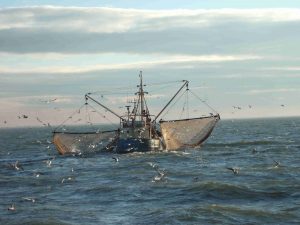Trawling
There are many different types of trawling, and although they can all broadly be described as “towing a net through the water”, the type of fish being targeted determines the position in water at which the net is towed, its geometry, the part of the boat from which it is being towed – and even the number of nets in use.
 Many types of trawling do not regularly take place in the EIFCA District, and often the use of certain trawl types is quite location-specific. Suffolk probably sees the majority of the fish-trawling activity, with relatively small inshore trawlers using stern and side trawls to fish for demersal species (including flat-fish). In The Wash, most of the boats can be geared up to prosecute a diverse range of fisheries, and many of the boats seasonally target brown shrimp (Crangon crangon) and pink shrimp (Pandalus montaguii). For this, the boats are usually rigged with twin shrimp beam trawls – this is relatively light gear with rollers fitted to the beams.
Many types of trawling do not regularly take place in the EIFCA District, and often the use of certain trawl types is quite location-specific. Suffolk probably sees the majority of the fish-trawling activity, with relatively small inshore trawlers using stern and side trawls to fish for demersal species (including flat-fish). In The Wash, most of the boats can be geared up to prosecute a diverse range of fisheries, and many of the boats seasonally target brown shrimp (Crangon crangon) and pink shrimp (Pandalus montaguii). For this, the boats are usually rigged with twin shrimp beam trawls – this is relatively light gear with rollers fitted to the beams.
Bottom trawls (such as the shrimp beam trawl) work by disturbing the fish so that they jump up from the seabed and into the net above. At the end of a tow, the fishermen raise the nets and bring the “codend” (the end of the net where all the fish are gathered) aboard to empty the catch so that it can be sorted and processed.
